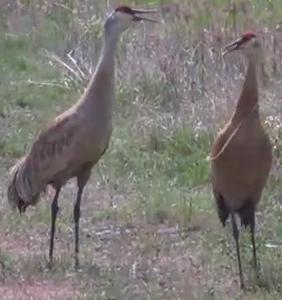Sandhill Crane 
Identification and Pictures and
Video
Video above is a pair of Sandhill Cranes
walking around a field, they have a nest nearby. For
other bird videos please visit our Youtube channel and
subscribe or like our videos.
Sandhill Crane (Grus canadensis)
The Sandhill Crane is a tall gray bird, with
long legs, a long neck, a bald red crown, and a thick tufted
plume of long, drooping feathers over the tail. they
also have a long pointed bill and white cheeks. Some
birds will also have a rust color. The birds often rub
mud on their feathers while preening, giving them the red or
brown color. They grow to around
47 inches tall. Their wing span is 6
to 7 feet and when they fly their neck is fully extended,
unlike the similar species (blue
herons), which fly with their
neck in an S shape. Male and female cranes look
alike. The young birds are brownish and do not have the
red crown. They can live for 20 years. They have
been found to structurally the same as 10 million old fossils.
Sandhill cranes are often found in large
groups or pairs, and are very social birds.
Sound
The call of Sandhill cranes sounds like low
musical rattle, and can have varied lengths, depending on why
they are calling. Two other sounds they make are
tuk-tuk-tuk and a goose-like honk. Listen to the rattle
sound. You can also hear this rattle in the video
above.
Preferred Habitat
Sandhill cranes are usually found in in freshwater wetlands,
marshes, river basins, wet grasslands, and prairies.
There are several subpopulations, some of the cranes are migratory, and some are
not. For most of those that do migrate the summer range
is northern U.S. through Canada and Alaska. They may
winter in the southern U.S. and Mexico. Cranes gather in
large flocks before a migration.
Breeding and Nesting
Breeding season for Sandhill cranes is from
early spring to late fall. The cranes mate for
life. Pairs will often do displays where they dance,
bow, jump, and raise their bills together. A pair will
defend its nesting territory with singing duets, displays, and
sometimes stabbing with the bill or kicking aggressively.
The two birds build a nest that is a hay like mound in a
marsh, and the female usually lays 2 pale eggs with brown
spots. Both birds incubate the eggs for around 30 days,
the female is usually the only one that takes the night shift. The young birds can follow the parents and forage
within 24 hours of hatching, and they can fly in about 2
months. The young birds may stay with their parents until
about a month before nesting season.
Food
While the cranes like to eat grains and plants, they will also
eat invertebrates, reptiles, amphibians and small mammals.
To learn about other favorite
birds click here.

|
